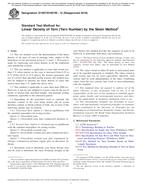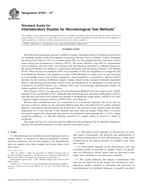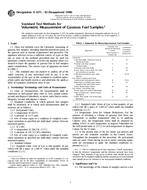1.1 This specification covers commercial zinc, zinc-aluminum castings and continuous cast bar stock, as designated and specified in Table 1. Seven alloy compositions are specified and designated as follows:
| Common | Traditional | ASTM A | UNS |
|---|---|---|---|
| Alloy 3 | Zamak 3 | AG 40A B | Z33520 |
| Alloy 7 | Zamak 7 | AG 40B | Z33523 |
| Alloy 5 | Zamak 5 | AC 41A B | Z35531 |
| Alloy 2 | Zamak 2 | AC 43A | Z35541 |
| ZA-8 | ZA-8 | … | Z35636 |
| ZA-12 | ZA-12 | … | Z35631 |
| ZA-27 | ZA-27 | … | Z35841 |
| _________ |
A See Table 1, Footnote C.
B SAE Specification, Nos. 903 and 925 conform to the requirements for alloys AG40A and AC41A, respectively.
1.2 Zinc Alloys Z33520, Z33523, Z35531, and Z35541 are used primarily in the manufacture of pressure die castings. Zinc-Aluminum Alloys Z35636, Z35631, and Z35841 are used in the manufacture of both foundry and pressure die castings. These alloys are also fabricated into continuous cast bar stock used for prototyping and screw machine stock.
1.3 The values stated in inch-pound units are to be regarded as standard.
1.4 Systems of nomenclature used to designate zinc and zinc-aluminum (ZA) alloys used for casting are described in Appendix X1.
1.5 This standard does not purport to address all of the safety concerns, if any, associated with its use. It is the responsibility of the user of this standard to become familiar with all hazards including those identified in the appropriate Material Safety Data Sheet (MSDS) for this product/material as provided by the manufacturer, to establish appropriate safety and health practices, and determine the applicability of regulatory limitations prior to use.
TABLE 1 Chemical Requirements
| Element | Alloy 3A,B,C,D Zamak 3 (AG40A) Z33520 |
Alloy 7A ,B,C,D Zamak 7 (AG40B) Z33523 |
Alloy 5A,B,C,D Zamak 5 (AC41A) Z35531 |
Alloy 2A,C,,D Zamak (AC43A) Z355412 |
ZA-8A,C,E ZA-8 Z35636 |
ZA-12A,C ,E ZA-12 Z35631 |
ZA-2A,C,E ZA-27 Z35841 |
|---|---|---|---|---|---|---|---|
| Aluminum | 3.5-4.3 | 3.5-4.3 | 3.5-4.3 | 3.5-4.3 | 8.0-8.8 | 10.5-11.5 | 25.0-28.0 |
| Magnesium | 0.020-0.05F | 0.005-0.020 | 0.03-0.08F | 0.020-0.050 | 0.015-0.030 | 0.015-0.030 | 0.010-0.020 |
| Copper | 0.25 maxG | 0.25 max | 0.75-1.25 | 2.5-3.0 | 0.8-1.3 | 0.5-1.2 | 2.0-2.5 |
| Iron, max | 0.100 | 0.075 | 0.100 | 0.100 | 0.075 | 0.075 | 0.075 |
| Lead, max | 0.005 | 0.003 | 0.005 | 0.005 | 0.006 | 0.006 | 0.006 |
| Cadmium, max | 0.004 | 0.0020 | 0.004 | 0.004 | 0.006 | 0.006 | 0.006 |
| Tin, max | 0.003 | 0.0010 | 0.003 | 0.003 | 0.003 | 0.003 | 0.003 |
| Nickel | . . . | 0.005-0.020 | . . . | . . . | . . . | . . . | . . . |
| ZincH | remainder | remainder | remainder | remainder | remainder | remainder | remainder |
A For purposes of acceptance and rejection, the observed value or calculated value obtained from analysis should be rounded to the nearest unit in the last right-hand place of figures, used in expressing the specified limit, in accordance with the rounding procedure prescribed in Practice E 29.
B Zinc alloy castings may contain nickel, chromium, silicon, and manganese in amounts of 0.02, 0.02, 0.035, and 0.06 % respectively. No harmful effects have ever been noted due to the presence of these elements in these concentrations and, therefore, analyses are not required for these elements, with the exception of nickel analysis for Z33522.
C ASTM alloy designations were established in accordance with Practice B 275. The UNS designations were established in accordance with Practice E 527. The last digit of a UNS number differentiates between alloys of similar composition. The UNS designations for ingot and casting versions of an alloy were not assigned in the same sequence for all alloys.
D When this material is required to conform to ISO 301, the chemical limits for thallium and indium each shall not exceed 0.001 %.
E Zinc-aluminum ingot for foundry and pressure die casting may contain chrome, manganese, or nickel in amounts of up to 0.01 % each or 0.03 % total. No harmful effects have ever been noted due to the presence of these elements in up to these concentrations and, therefore, analyses are not required for these elements.
F Magnesium may be as low as 0.015 % provided that the lead, cadmium, and tin do not exceed 0.003, 0.003, and 0.001 % respectively.
G For the majority of commercial applications, a copper content in the range from 0.25 to 0.75 % will not adversely affect the serviceability of die castings and should not serve as a basis for rejection.
H Determined arithmetically by difference.
Product Details
- Published:
- 04/15/2009
- Number of Pages:
- 8
- File Size:
- 1 file , 120 KB
- Redline File Size:
- 2 files , 200 KB


